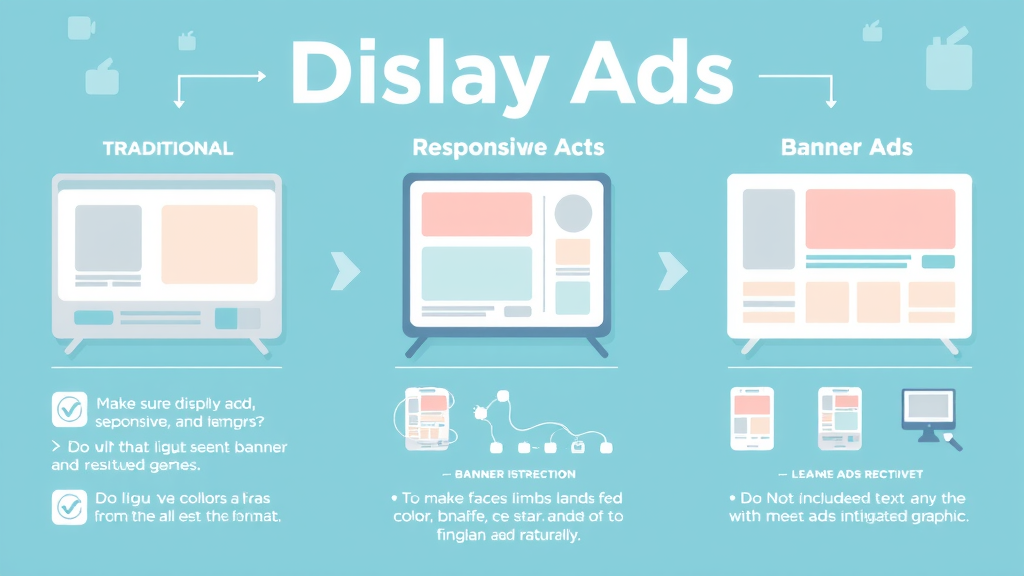Did you know? The average click-through rate for display ads is just 0.46% across all industries. Imagine tripling that number—how would that transform your advertising campaign ROI?

What You’ll Learn from This Article
- The psychology behind high-performing display ads
- Advanced targeting and segmentation tips
- Design hacks proven to increase engagement and clicks
- How to optimize across the Google Display Network
- Metrics you must track for breakthrough growth
"The average click-through rate for display ads across all industries is just 0.46%. Imagine if you could triple that—and what it would mean for your business."
Discover How Strategic Display Ads Can Skyrocket Your Results
In today’s crowded digital landscape, simply running a display ad is not enough. Strategic display ads—backed by psychological insight, advanced technology, and rigorous analytics—are what separate brands that struggle from those that dominate their markets. By optimizing your display network targeting, crafting irresistible banner ad creative, and leveraging modern tools for continuous optimization, you unlock new levels of engagement, clicks, and conversions. These are not just generic tips—they are proven hacks used by brands on the leading edge of digital advertising to consistently outperform the competition.
Whether you’re aiming to boost brand awareness , generate leads, or drive direct sales, mastering your display advertising strategy on platforms like the Google Display Network and beyond is essential. Many marketers focus on search ad campaigns, leaving display ads overlooked; but with the right enhancements, your ads can reach people across thousands of sites and apps in a visually engaging way. If you implement these actionable steps shared here, you can transform your ad campaigns from average to exceptional.
Understanding Display Ads: The Fundamentals for Explosive Growth

What Are Display Ads and Why Do They Matter?
Display ads are visual digital ad formats that appear across websites, mobile apps, and social media platforms. Unlike the simple text of a search ad, display ads utilize images, videos, animation , and clear call to action prompts to capture audience interest. What makes display advertising so effective is its ability to reach people at different stages of the buying journey—building brand awareness for new prospects and retargeting previous visitors to encourage action. The flexibility of display ad formats , from responsive display ads that adapt to multiple screens to classic banner ads in fixed sizes, offers creative freedom and expansive reach.
Display ads matter because they allow you to target specific demographics, interests, and behaviors on an enormous scale, thanks to vast ad networks like Google Display Network . When executed with the right strategies, display ads are visual tools that spark engagement far beyond what typical text-based ads can accomplish . Tailoring your digital advertising efforts to include both search and display not only extends your campaign performance, but also keeps your brand top-of-mind wherever your target audience browses, shops, or consumes content.
The Role of Display Advertising in the Modern Marketing Mix
In the modern marketing mix, display advertising serves as both a brand-building and conversion-driving powerhouse. While search ads target people with clear intent, display ad campaigns excel at capturing attention from passive browsers and re-engaging users who may not be ready to take action immediately. This dual capability is especially powerful for integrated strategies: display ads amplify brand awareness for new customers while running alongside search ads and social media campaigns to guide users through the conversion funnel.
Furthermore, advances in responsive display ads and dynamic creative optimization allow marketers to deliver highly relevant messages to the right audience, at the right time, on the right platform. Leveraging machine learning and automated bidding, display advertising continuously evolves, making it a cornerstone of digital marketing that no modern brand can afford to ignore.
Comparison of Display Ad Formats
| Ad Type | Formats/Sizes | Network Compatibility | Engagement Potential |
|---|---|---|---|
| Traditional Display Ads | Fixed ad size (e.g., 300x250, 728x90), standard image or animation formats | Most ad networks (Google Display, programmatic, direct buys) | Moderate, relies on creative quality and placement |
| Responsive Display Ads | Automatically adapts image, text & size to fit available ad space | Highly compatible, designed for Google Display Network and modern platforms | High, personalized, shown in optimal formats for each placement |
| Banner Ads | Common sizes: 300x250, 160x600, 728x90, static or animated | Widespread; websites, apps, social media | Variable, depends on placement and visual impact |
Key Elements of High-Performing Display Ads
Crafting Irresistible Visuals: Banner Ads and Responsive Display Ads

The foundation of any high-performing banner ad or responsive display ad is compelling visual design. Rich, eye-catching graphics, bold color contrast, and clear branding instantly attract attention in a crowded digital ad space. With responsive display ads , you can upload multiple assets—images, headlines, and descriptions—allowing the platform’s AI to automatically find the best combination for performance. This automation ensures your display advertising stays visually engaging and adapts seamlessly to various screen sizes and |ad formats|.
But visual appeal is not just about creativity—it’s about conversion. Successful display ads combine dynamic visuals with data-backed design choices. Ensure every creative element reinforces your value proposition, highlights your brand, and guides the viewer’s eye to the desired call to action. Use imagery relevant to your offer, leverage whitespace for clarity, and always test different color schemes and visuals for maximum results.
For marketers looking to take their retargeting efforts to the next level, exploring customer retargeting strategies that boost conversions can provide actionable insights to complement your display ad campaigns and drive even higher engagement.
Write Persuasive Copy and Calls to Action That Convert
Copywriting for display ads means saying more with less. Every word on your banner ad or responsive display ad should highlight a clear benefit, differentiate your offer, and direct the viewer toward a single, compelling call to action. High-performing campaigns use succinct headlines, powerful verbs, and clear instructions like "Shop Now," "Get Free Quote," or "Start Your Free Trial." Testing different versions of your call to action is critical: even a minor change in phrase or button color can make a major difference in click-through rates.
Effective ad copy should reinforce brand awareness and connect emotionally with the target audience. Combine this with a crisp value proposition and reinforce your brand name or logo in every creative. Remember, your display ads are visual invitations to further engagement on your site or landing page—make every word count.
Choose the Best Ad Size for Maximum Impact
Selecting the optimal ad size can significantly impact your campaign performance across the display network . Some sizes, like 300x250 (medium rectangle), 728x90 (leaderboard), and 160x600 (wide skyscraper), are considered the most effective due to their widespread support and prime visibility spots on publisher sites. Using responsive display ads ensures your creative fits into myriad ad spaces, optimizing reach and impressions.
To maximize results, include all recommended sizes in your Google Ads campaign and tailor your artwork for each dimension. Regularly analyze which sizes perform best within your network and prioritize those that consistently deliver higher click-through rates and conversions.
- Clear brand identity & logo
- Compelling value proposition
- Standout call to action
- Mobile-friendly design
- Brand awareness reinforcement
Display Ads Placement: Where and How Your Ads Work Best
Exploring the Google Display Network: Reach, Audience, and Opportunity

The Google Display Network (GDN) is one of the largest ad networks, offering access to millions of websites, apps, and digital properties worldwide. This expansive reach allows advertisers to target audience segments at scale, from niche enthusiasts to broad demographic groups. The GDN supports multiple ad formats, including standard image ads, responsive display ads, and rich media options, giving you flexibility to tailor your creative to different placements and screen types.
The real strength of the GDN lies in its advanced targeting and optimization tools. Combine contextual targeting, in-market segments, interest categories, and retargeting lists to get your display ads in front of the people most likely to engage. With the GDN, you ensure that your brand appears where your future customers are already spending their time, enhancing brand awareness and increasing the opportunity for conversion.
Display Ads Beyond Google: Social Media, Websites, and More
While Google Display Network is pivotal, don’t overlook platforms like social media networks (Facebook, Instagram, LinkedIn), specialized ad networks, and direct display placements on influential blogs or industry websites. Each network offers unique audience targeting opportunities and creative ad placements, further expanding the visibility of your campaigns beyond the Google ecosystem.
On social media, display ads can leverage platform-specific interactive features, lookalike audience targeting, and advanced analytics, making them a powerful complement to your GDN approach. Mixing placements helps mitigate “banner blindness,” enhances campaign reach, and provides invaluable first-party data for future optimization.
Advanced Targeting Strategies for Display Ads Success
Segmentation and Custom Audiences: Precision in Display Advertising

Advanced segmentation empowers you to tailor display ads for specific custom audiences based on demographic data, interests, device usage, and online behaviors. With tools in Google Ads and other platforms, you can create in-market audiences and custom intent audiences —groups of users actively researching products or demonstrating purchase signals. Segmenting your campaigns ensures every ad creative and message speaks directly to the needs, desires, and context of your highest-value prospects.
Beyond demographics, behavioral segmentation allows you to refine your digital ad targeting based on actions like website engagement, video views, or previous interactions with your brand. Combining these layers of data leads to stronger campaign performance, greater ad relevance, and higher returns on your ad spend.
Retargeting and Remarketing: Turn Browsers into Buyers
Retargeting (a form of remarketing) is one of the most effective ways to increase conversion rates within your display ad campaigns. By segmenting audiences who visited your site but didn’t convert—perhaps they abandoned a cart or browsed a product page—you can show them personalized ads as they browse other websites or social media. These timely reminders reignite interest, boost brand awareness , and are statistically proven to improve click-through rates and revenue.
Google Display Network, Facebook Ads, and leading ad networks offer robust remarketing tools that allow you to sync audiences, create sequenced campaigns, and tailor creative to each stage of the buyer journey. Successful advertisers consistently monitor and optimize remarketing segments to maximize return on ad spend and minimize wasted impressions.
Layering Demographics, Interests, and Behaviors for Maximum ROI
For breakthrough ROI, layer targeting options in your display ad campaign : select age, gender, parental status, combine interests or life events, and overlay with recent search or site activity. This multi-dimensional approach enables you to pinpoint your most qualified leads, control ad frequency, and drive efficiency in your digital advertising campaigns. The beauty of advanced targeting is the ability to experiment, analyze, and refine—continually zeroing in on what works best for each segment.
Don’t forget to track exclusion lists and negative audiences to avoid wasted impressions and better allocate your ad spend. Smart targeting, refined over time, is the backbone of scalable, cost-effective display advertising.
- Interest categories
- In-market audiences
- Remarketing lists
- Life events
- Custom intent audiences
Design & Copywriting Hacks: Making Display Ads POP
Visual Storytelling: Color, Contrast, and Readability in Banner Ads

The secret to visually engaging banner ads lies in bold storytelling—leveraging color psychology , accessible fonts, powerful imagery, and high contrast. Studies show color combinations and whitespace not only capture attention but also increase comprehension and recall. Always ensure your text stands out from the background, key elements aren’t cluttered, and there’s ample room for your call to action .
For best results, align your display ad visual style with brand guidelines but don’t be afraid to break monotony. Test unexpected color pairings, graphical icons, or playful animation to boost user interaction and stand out in crowded ad spaces. The best banner ads tell a story at a glance, compelling viewers to pause, consider, and click.
Responsive Display Ads: Automation with Personality
Responsive display ads use AI-driven automation to assemble the most effective ad combinations in real time. By uploading a variety of images, headlines, and descriptions, the system tests multiple combinations to find the top performers for each placement across the Google Display Network and other programmatic ad networks. However, automation does not mean generic: inject brand personality into each asset, and let the system optimize for scale without losing your unique voice.
Reviewing performance reports can reveal which headlines resonate, which images prompt the most clicks, and where creative fatigue may occur. Take time quarterly to refresh creative assets for responsive display ads to maintain engagement and advertise in line with evolving trends in digital advertising.
Testing Different Headline & Call to Action Variations
One of the simplest—and most powerful—ways to increase display ad performance is ongoing testing (A/B or multivariate) of headlines and calls to action. Experiment with direct versus benefit-focused headlines, emotional drivers, urgency (like "Limited Time Offer!"), and different action prompts. Don’t assume; let data be your guide.
Best-in-class advertisers establish a creative testing calendar: new headline combinations monthly, fresh CTA buttons each quarter, and routine audience feedback. Consistent refinement ensures your display ad never goes stale and is always tuned for your evolving audience.
Optimizing Display Ad Campaigns for Consistently Higher Clicks

Monitoring Performance Metrics: CTR, Impressions, and Conversions
If you’re serious about tripling your clicks, you need to become obsessed with metrics: Click-Through Rate (CTR) , impressions, conversions, viewable impressions, and cost per acquisition (CPA). These key indicators reveal which display ad creatives, ad sizes, and placements are working and where there’s optimization potential. Set benchmarks for each campaign and review weekly reports from Google Ads and your preferred ad network.
Use pixel-based conversion tracking to link ad engagement directly to downstream actions (sign-ups, purchases, downloads). Monitor trends for ad fatigue—when performance drops due to overexposure. Move budget dynamically to the top-performing ads and retire underperformers swiftly.
Continuous Testing and Iteration for Display Ads
Great advertisers don’t set and forget—they iterate constantly. Implement A/B testing for imagery, headlines, ad size, and calls to action. Rotate new creative every month and archive historical winners for reference. Use analytics not just to measure, but to fuel your creative process: let campaign performance insights guide future experiments for sustained growth.
Don’t rely solely on past successes—digital advertising trends evolve rapidly. Stay alert for seasonal trends, new offers, and shifts in your target audience’s behavior, and update your display ads accordingly for maximum ongoing impact.
Budgeting and Bidding Strategies with Google Ads & Display Ad Campaigns
Smart allocation of ad spend is integral to scaling your display ads profitably. Leverage automated bidding options in Google Ads—such as Target CPA or Maximize Conversions—and adjust budgets dynamically based on live performance data. Reallocate funds away from underperforming placements to the ad sizes and networks consistently generating conversions.
Experiment with dayparting (showing ads at optimal times), frequency caps (limiting how often an ad is shown to the same user), and geo-targeting to concentrate efforts where ROI is highest. Keep a quarterly review rhythm to align budget with changing market dynamics and seasonal opportunities.
- Review ad performance weekly
- Test new creatives monthly
- Adjust targeting based on data
- Reallocate budget to best performers
Case Studies: Display Ad Hacks in Action

How One Brand Used Google Display Network for a 3x CTR Boost
A fast-growing SaaS company seeking to revamp their stagnant display ad campaign implemented dynamic creative optimization across the Google Display Network . By pairing segmented audience lists with automated ad format testing, they increased ad engagement and ramped up brand awareness . Over the course of two months, click-through rates jumped by over 285%.
"Implementing dynamic creative on the Google display network increased our click-through rate by 285% in just 2 months." – Marketing Manager, SaaS Company
The campaign’s success was fueled by continuous headline and call to action testing, fresh creative cycles, and frequent audience refinement. The takeaway: simply setting up a display ad isn’t enough—you need relentless experimentation and advanced targeting to stand above the noise and consistently drive more clicks.
Lessons from Failed Display Ad Campaigns
Not every campaign succeeds. In one case, an e-commerce retailer relied solely on generic banner ads, ignored mobile formatting, and used the same static headline for months. The result? Low CTR, declining impressions, and missed revenue. Postmortem analysis revealed that lack of fresh creative, ignoring responsive display ads, and poor demo targeting were major missteps.
The lesson: continuous creative refresh, frequent A/B testing, agile targeting, and mobile-first design principles are essential. Benchmark against successful ads—and don’t fear fast iteration.
Experts Answer: People Also Ask About Display Ads
What is the difference between PPC and display ads?
Display ads appear as visual banners on publisher websites, apps, and social channels, whereas PPC often refers to text ads in search results or other placements where you pay per click. Display ads focus on brand awareness, targeting, and visual engagement, while PPC is typically search-intent driven and aims for immediate conversions through user queries.
What is the difference between Google Ads and display ads?
Google Ads is the broader platform providing tools to run multiple campaign types: display, search, shopping, and YouTube ads. Display ads are a specific campaign type within Google Ads, showing visual creatives (banners, animations, responsive ads) to engage users across the Google Display Network .
Where do display ads appear?
Display ads appear across an enormous range of placements: Google Display Network sites and apps, social media platforms like Facebook, Instagram, and LinkedIn, mobile applications, and third-party ad partner networks. Essentially, anywhere that supports digital ad placements can host your display advertising efforts.
Are display ads still effective?
Absolutely. When paired with advanced audience targeting, creative automation, and ongoing optimization, display ads remain highly effective. Modern platforms provide robust segmentation, retargeting, and creative testing tools, making display campaigns even more powerful for driving both brand awareness and measurable conversions.
Frequently Asked Questions: Maximizing Display Ads Performance
How do I measure the ROI of my display advertising campaigns?
Track core metrics like impressions, clicks, conversions, cost per conversion, and overall return on ad spend (ROAS). Pair Google Analytics with your ad network’s reporting to attribute revenue or conversions directly to your display ad activity. Consider both direct and assisted conversions to understand the full value of your ads’ impact.
Can display ads complement my search and social campaigns?
Yes. Display ads help fill the top of the funnel, build brand awareness , and nurture audiences through strategic retargeting. When integrated with search and social campaigns, display advertising keeps your brand visible and engaging throughout the entire customer journey.
What is the best way to test new ideas in display ads?
Use A/B testing to compare creative, headlines, and CTA buttons. Run small-scale tests before rolling out changes network-wide. Leverage Google Ads’ responsive display option for automatic testing of different asset combinations, and use campaign performance data to guide your next round of creative experiments.
Leading Edge Trends: Display Ads in 2024 and Beyond
AI-Powered Creative and Responsive Display Innovations

Artificial intelligence now drives much of the innovation in display advertising . Next-gen responsive display ads not only optimize combinations of images and headlines but can generate entirely new creative assets tailored to audience behavior in real time. Brands leveraging AI enjoy higher conversion rates, scalable personalization, and an ongoing edge as advertising trends evolve.
Greater Personalization and Privacy-First Targeting
As privacy regulations evolve, privacy-first targeting is shaping the future of all digital advertising. Expect more granular consent management and greater reliance on first-party data and contextual signals to personalize messages. Responsive display ads powered by machine learning will enable ethical, high-performing campaigns that respect consumers and build trusted relationships.
Take Your Display Ads to the Next Level
Ready to triple your display ad clicks and see real results? Call us at (385) 469-1869 or email info@solu4u.com today!
Action Steps: Audit your campaigns, update creative, test targeting layers, and embrace continuous optimization. The road to triple clicks starts today!
If you’re eager to expand your digital advertising expertise beyond display ads, consider exploring online advertising secrets that boost sales fast . This resource dives into holistic strategies and advanced techniques that can elevate your entire marketing approach, helping you integrate display, search, and social campaigns for maximum impact. By broadening your perspective and applying proven methods across channels, you’ll be well-positioned to accelerate growth and outpace your competition. Take the next step and unlock the full potential of your online advertising efforts.
Sources
- https://support.google.com/google-ads/answer/2404191?hl=en
- https://wordstream.com/blog/ws/display-advertising
- https://www.hubspot.com/marketing-statistics
- https://blog.hootsuite.com/display-ads/
- https://www.searchenginejournal.com/google-display-network-guide/248809/
To enhance your understanding of display advertising and implement strategies that can significantly increase your click-through rates, consider exploring the following resources:
-
“Display Advertising: Definition, Types, Benefits, and How-to” : This comprehensive guide from AdRoll delves into the various forms of display ads, their advantages, and practical steps to create effective campaigns. It offers insights into targeting strategies and the importance of visual appeal in capturing audience attention. ( adroll.com )
-
“What Are Display Ads? Definition & Best Practices” : Forbes Advisor provides a detailed overview of display ads, including best practices for designing compelling visuals and crafting persuasive copy. The article emphasizes the significance of clear calls to action and aligning ad design with brand identity to maximize engagement. ( forbes.com )
By integrating the strategies and insights from these authoritative sources, you can refine your display advertising approach to achieve higher engagement and improved campaign performance.
 Add Row
Add Row  Add
Add 




Write A Comment